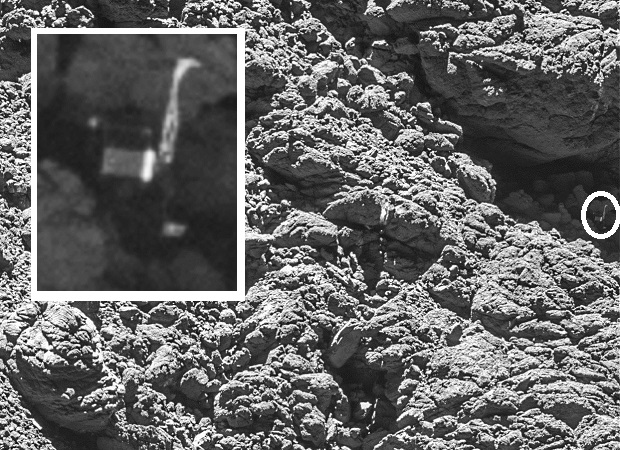Missing comet lander Philae spotted at last — ESA

The photo released by European Space Agency ESA on Monday, Sept. 5, 2016 shows the comet lander Philae (circled) in a crack on the right side of a photo taken by Rosetta’s OSIRIS narrow-angle camera on Sept. 2, 2016 from a distance of 2.7 km of the Comet 67P/Churyumov–Gerasimenko. Philae was last seen when it first touched down at Agilkia, bounced and then flew for another two hours before ending up at a location later named Abydos, on the comet’s smaller lobe. (ESA/Rosetta/MPS for OSIRIS via AP)
PARIS, France — Europe’s Rosetta spacecraft has finally spotted its tiny lander Philae, thought to be lost forever, stuck in a ditch on the surface of a comet hurtling through space, ground controllers said Monday.
“THE SEARCH IS OVER! I’ve found @Philae2014!!” the European Space Agency (ESA) tweeted on behalf of Rosetta, orbiting comet 67P/Churyumov-Gerasimenko at some 682 million kilometers (424 million miles) from Earth.
READ: Philae lander on comet may communicate again
The agency released a photo of the washing machine-sized robot lab on the comet’s rough surface, one of its three legs thrust dramatically into the air.
This was the first sighting of Philae since its rough landing in November 2014.
The image was captured by Rosetta’s OSIRIS narrow-angle camera on Friday and downloaded two days later — just weeks before the official end of the ground-breaking science mission to unravel the mysteries of life on Earth.
“With only a month left of the Rosetta mission, we are so happy to have finally imaged Philae and to see it in such amazing detail,” Cecilia Tubiana of the OSIRIS camera team, the first person to see the images, said in a statement.
READ: Philae’s comet may host alien ‘life’–astronomers
The Twitter page of Philae, its communications unit switched off in July, remained silent.
The 100-kilogram (220-pound) probe touched down on comet 67P in November 2014, after a 10-year, 6.5 billion-kilometer (four billion-mile) journey piggybacking on Rosetta.
Philae bounced several times after its harpoons failed to fire, and ended up in a ditch shadowed from the Sun’s battery-replenishing rays.
Until now, nobody knew exactly where.
The final hour
The tiny lab managed to conduct 60 hours of experiments and send home data before running out of power and entering standby mode on November 15, 2014.
“We were beginning to think that Philae would remain lost forever. It is incredible that we have captured this at the final hour,” said Rosetta mission manager Patrick Martin.
The photo was taken at a distance of 2.7 kilometers from the surface of the comet, which is speeding away from the Sun at nearly 15 kilometers per second.
Rosetta is drawing closer to the comet for its own swansong.
On September 30, Rosetta will crash land and join Philae on the surface — their eternal resting place.
After it touches down, communications with the craft will be severed once and for all, closing the historic mission.
The 1.3-billion-euro ($1.4-billion) project was conceived to unravel the secrets of comets — believed to be time capsules from the birth of the Solar System.
The comet-sniffing and -prodding exploits of Rosetta and Philae were closely followed around the world via cartoon recreations of the pioneering pair.
Philae, in particular, earned a loyal Twitter following.
In June 2015, as it drew closer to the Sun, some 30,000 people retweeted Philae’s unexpected reawakening: “Hello Earth! Can you hear me?”
After eight intermittent communications with ground control, Philae fell forever silent in July 2015.
“Philae is at the foot of a cliff in an extremely rocky zone” of the comet, Rosetta project chief Philippe Gaudon of France’s CNES space agency told AFP, after examining the picture.
It is now clear that after bouncing, Philae landed the wrong-way up, “with one foot well in the air and its antennas pointing… groundwards,” he said.
That is why communicating with Philae had been so difficult.
“This wonderful news means that we now have the missing ‘ground-truth’ information needed to put Philae’s three days of science into proper context, now that we know where that ground actually is,” said Rosetta project scientist Matt Taylor.